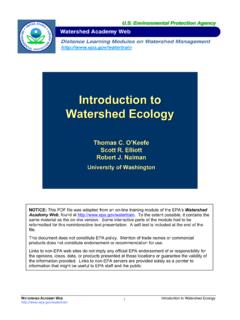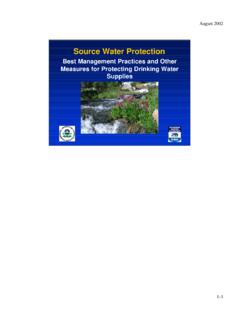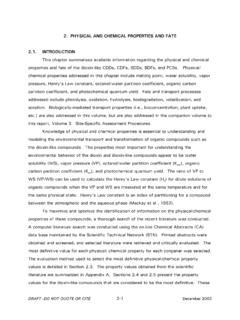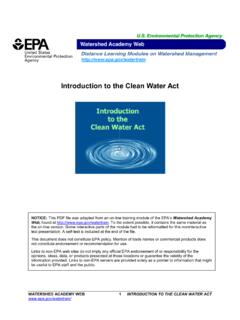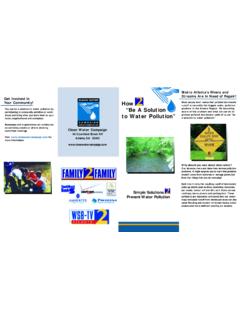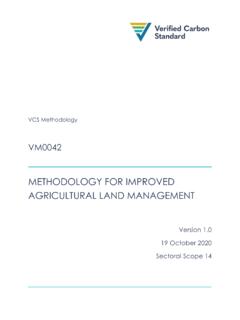Transcription of Principles of Watershed Management - U.S EPA Web Server
1 Watershed ACADEMY WEB Principles of Watershed Management . 1 NOTICE: This PDF file was adapted from an on-line training module of the EPA s Watershed Academy Web, found at To the extent possible, it contains the same material as the on-line version. Some interactive parts of the module had to be reformatted for this noninteractive text presentation. Review questions are compiled at the end of the file as a self-test. This document does not constitute EPA policy. Mention of trade names or commercial products does not constitute endorsement or recommendation for use.
2 Links to non-EPA web sites do not imply any official EPA endorsement of or responsibility for the opinions, ideas, data, or products presented at those locations or guarantee the validity of the information provided. Links to non-EPA servers are provided solely as a pointer to information that might be useful to EPA staff and the public. Principles of Watershed Management Watershed ACADEMY WEB Principles of Watershed Management .
3 2 Welcome to the Principles of Watershed Management module. This module has four main purposes. It should increase understanding of: 1. basic Watershed processes and their interrelated nature, 2. the Principles of long-term Watershed Management , 3. the elements of successful Watershed Management frameworks, and 4. the benefits of the Watershed Management approach. Watershed Management approaches are evolving throughout the country and are being used to solve tough problems. On the following pages are 6 examples of successful Watershed Management cases.
4 Based on successful Watershed Management efforts like these across the country, this tutorial presents four core Principles of Watershed Management : 1. Watersheds are natural systems that we can work with. 2. Watershed Management is continuous and needs a multi-disciplinary approach. 3. A Watershed Management framework supports partnering, using sound science, taking well-planned actions and achieving results. 4. A flexible approach is always needed. SIX SUCCESSES IN Watershed Management Merrimack River Initiative, New England: Public and Private Partners Collaborate to Build Watershed Toolbox to Aid Management Decision-Making In New England, the Merrimac River Initiative has brought together the States of New Hampshire and Massachusetts with USEPA and the NE Interstate Water Pollution Control Commission to collaborate on water quality issues.
5 This has resulted in many joint projects and successes, some of which are collectively referred to as the Watershed Toolbox (Figure 1). These tools not only aid Management decision-making and implementation but also make it easier for partners to communicate. Figure 1: The Watershed Toolbox that helps Merrimack partners work together to address water quality issues. Watershed ACADEMY WEB Principles of Watershed Management . 3 Boulder Creek, Colorado Watershed Project: Restoring Multiple River Corridor Values and Uses by Choosing Most Cost-Effective Strategies A local wastewater treatment plant was targeted for an expensive upgrade to reduce nitrate levels believed to be responsible for an ammonia toxicity problem in Boulder Creek.
6 Intensive-survey monitoring of Colorado s Boulder Creek indicated a number of other factors could be contributing to the decline of the diverse fish populations from the Creek s mountain canyon to its high plains. For example, stream monitors found stream habitat so degraded that it was unsuitable for most forms of aquatic life and could be contributing to the buildup of toxic concentrations of ammonia in the water. A physical habitat restoration program was undertaken to restore the complexity of the stream channel, stabilize the streambanks, revegetate the riparian corridor, create buffer strips to reduce agricultural and grazing runoff, and rebuild diversion and return flow structures to minimize impacts on aquatic habitat.
7 Because of limited funding, key portions of the channel were prioritized and targeted for restoration. The BMPs, habitat restoration, and scaled-back point source nutrient control program were successful in reducing ammonia toxicity problems and revitalizing fish populations in the Creek. Boulder Creek now provides the primary corridor for an urban natural area park system (Figure 2). Occoquan Water Supply Protection: Looking at Best Use of Land Throughout Watershed , Local Governments Meet Multiple Objectives In the mid-eighties, several counties in the rapidly urbanizing area of Virginia developed a comprehensive land use plan for the Occoquan Reservoir Watershed and adopted zoning ordinances regulating the location, type, and intensity of future land uses.
8 This was done after maximizing the limits of treatment technology for the wastewater treatment plants discharging into the tributaries upstream of the reservoir and after intensive data collection and model development. Fairfax County took the lead in working with basin partners to study different land use development scenarios and how well they met multiple objectives such as: improved transportation system economic development efficient provision of community services, and no degradation of the Occoquan water supply.
9 Figure 2: Habitat restoration helped reduce ammonia toxicity problems in Boulder Creek. Watershed ACADEMY WEB Principles of Watershed Management . 4 Depending on the sensitivity of land areas in meeting specific objectives, portions of the Watershed were strategically upzoned and others downzoned (Figure 3). North Carolina Statewide Framework: Innovative, Cost-effective Solutions Through Partnerships and Leveraging North Carolina s statewide basin Management approach has resulted in more innovative, cost-effective Management .
10 In the Tar-Pamlico River Basin, the state water quality Management agency, a consortium of municipal and industrial discharge permittees, a local environmental organization, a national environmental advocacy group, and the state s soil and water agency forged a partnership to implement a pollutant trading program. The discharger consortium agreed to fund development of tools to evaluate Management alternatives, and provide cost-share funds to implement agricultural best Management practices in lieu of more costly nutrient removal processes at the wastewater treatment facilities (Figure 4).
